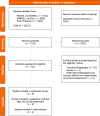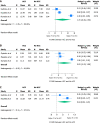Shear-wave elastography to predict hepatocellular carcinoma after hepatitis C virus eradication: A systematic review and meta-analysis
- PMID: 38596502
- PMCID: PMC11000078
- DOI: 10.3748/wjg.v30.i10.1450
Shear-wave elastography to predict hepatocellular carcinoma after hepatitis C virus eradication: A systematic review and meta-analysis
Abstract
Background: Direct-acting antiviral agents (DAAs) are highly effective treatment for chronic hepatitis C (CHC) with a significant rate of sustained virologic response (SVR). The achievement of SVR is crucial to prevent additional liver damage and slow down fibrosis progression. The assessment of fibrosis degree can be performed with transient elastography, magnetic resonance elastography or shear-wave elastography (SWE). Liver elastography could function as a predictor for hepatocellular carcinoma (HCC) in CHC patients treated with DAAs.
Aim: To explore the predictive value of SWE for HCC development after complete clearance of hepatitis C virus (HCV).
Methods: A comprehensive literature search of clinical studies was performed to identify the ability of SWE to predict HCC occurrence after HCV clearance. In accordance with the study protocol, a qualitative and quantitative analysis of the evidence was planned.
Results: At baseline and after 12 wk of follow-up, a trend was shown towards greater liver stiffness (LS) in those who go on to develop HCC compared to those who do not [baseline LS standardized mean difference (SMD): 1.15, 95% confidence interval (95%CI): 020-2.50; LS SMD after 12 wk: 0.83, 95%CI: 0.33-1.98]. The absence of a statistically significant difference between the mean LS in those who developed HCC or not may be related to the inability to correct for confounding factors and the absence of raw source data. There was a statistically significant LS SMD at 24 wk of follow-up between patients who developed HCC vs not (0.64; 95%CI: 0.04-1.24).
Conclusion: SWE could be a promising tool for prediction of HCC occurrence in patients treated with DAAs. Further studies with larger cohorts and standardized timing of elastographic evaluation are needed to confirm these data.
Keywords: Hepatitis C virus; Hepatocellular carcinoma; Shear-wave elastography; Sustained virologic response.
©The Author(s) 2024. Published by Baishideng Publishing Group Inc. All rights reserved.
Conflict of interest statement
Conflict-of-interest statement: All authors declare no conflicts-of-interest related to this article.
Figures


Similar articles
-
Impact of liver-stiffness measurement on hepatocellular carcinoma development in chronic hepatitis C patients treated with direct-acting antivirals: A systematic review and time-to-event meta-analysis.J Gastroenterol Hepatol. 2021 Mar;36(3):601-608. doi: 10.1111/jgh.15243. Epub 2020 Sep 10. J Gastroenterol Hepatol. 2021. PMID: 32875681
-
Liver stiffness and spleen stiffness predict distinct liver-related events after hepatitis C eradication with direct-acting antivirals.J Formos Med Assoc. 2024 Dec;123(12):1279-1286. doi: 10.1016/j.jfma.2024.02.016. Epub 2024 Mar 6. J Formos Med Assoc. 2024. PMID: 38453531
-
Significant decrease in liver stiffness detected by two dimensional shear-wave elastography after treatment with direct-acting antiviral agents in patients with chronic Hepatitis C.Turk J Gastroenterol. 2020 Feb;31(2):142-147. doi: 10.5152/tjg.2020.19418. Turk J Gastroenterol. 2020. PMID: 32141823 Free PMC article.
-
Multiparametric liver assessment in patients successfully treated for hepatitis C: a 4-year follow-up.Scand J Gastroenterol. 2024 Oct;59(10):1184-1191. doi: 10.1080/00365521.2024.2388691. Epub 2024 Sep 1. Scand J Gastroenterol. 2024. PMID: 39219192
-
Non-invasive prediction of post-sustained virological response hepatocellular carcinoma in hepatitis C virus: A systematic review and meta-analysis.Clin Mol Hepatol. 2024 Sep;30(Suppl):S172-S185. doi: 10.3350/cmh.2024.0262. Epub 2024 Aug 12. Clin Mol Hepatol. 2024. PMID: 39134075 Free PMC article.
Cited by
-
Comment: Non-invasive prediction of post-sustained virological response hepatocellular carcinoma in hepatitis C virus.Clin Mol Hepatol. 2025 Jan;31(1):e23-e24. doi: 10.3350/cmh.2024.1035. Epub 2024 Nov 26. Clin Mol Hepatol. 2025. PMID: 39587829 Free PMC article. No abstract available.
-
Chronic Hepatitis C Infection Treated with Direct-Acting Antiviral Agents and Occurrence/Recurrence of Hepatocellular Carcinoma: Does It Still Matter?Viruses. 2024 Dec 10;16(12):1899. doi: 10.3390/v16121899. Viruses. 2024. PMID: 39772206 Free PMC article. Review.
-
Liver stiffness assessed by elastography for the evaluation of hepatocellular carcinoma risk in patients with fibrosis: a systematic review and meta-analysis.Radiol Bras. 2025 Jun 2;58:e20240108. doi: 10.1590/0100-3984.2024.0108. eCollection 2025 Jan-Dec. Radiol Bras. 2025. PMID: 40502450 Free PMC article.
References
-
- Cui F, Blach S, Manzengo Mingiedi C, Gonzalez MA, Sabry Alaama A, Mozalevskis A, Séguy N, Rewari BB, Chan PL, Le LV, Doherty M, Luhmann N, Easterbrook P, Dirac M, de Martel C, Nayagam S, Hallett TB, Vickerman P, Razavi H, Lesi O, Low-Beer D. Global reporting of progress towards elimination of hepatitis B and hepatitis C. Lancet Gastroenterol Hepatol. 2023;8:332–342. - PubMed
-
- Martinello M, Solomon SS, Terrault NA, Dore GJ. Hepatitis C. Lancet. 2023;402:1085–1096. - PubMed
-
- Fehily SR, Papaluca T, Thompson AJ. Long-Term Impact of Direct-Acting Antiviral Agent Therapy in HCV Cirrhosis: Critical Review. Semin Liver Dis. 2019;39:341–353. - PubMed
-
- Toyoda H, Kikuchi K. Management of dialysis patients with hepatitis C virus in the era of direct-acting antiviral therapy. Ther Apher Dial. 2023;27:831–838. - PubMed
Publication types
MeSH terms
Substances
LinkOut - more resources
Full Text Sources
Medical

